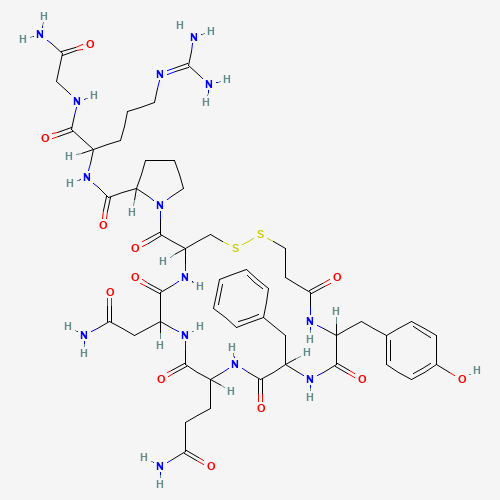| Pharmaceutical Information |
| Drug Name |
Desmopressin acetate |
| Drug ID |
BADD_D00617 |
| Description |
Desmopressin (dDAVP), a synthetic analogue of 8-arginine vasopressin (ADH), is an antidiuretic peptide drug modified by deamination of 1-cysteine and substitution of 8-L-arginine by 8-D-arginine. ADH is an endogenous pituitary hormone that has a crucial role in the control of the water content in the body. Upon release from the stimulation of increased plasma osmolarity or decreased circulating blood volume, ADH mainly acts on the cells of the distal part of the nephron and the collecting tubules in the kidney [T28]. The hormone interacts with V1, V2 or V3 receptors with differing signal cascade systems.
Desmopressin displays enhanced antidiuretic potency, fewer pressor effects due to V2-selective actions, and a prolonged half-life and duration of action compared to endogenous ADH [A31661]. It has been employed clinically since 1972 and is available in various formulations including intranasal solution, intravenous solution, oral tablet and oral lyophilisate [A31662]. Desmopressin is indicated for the treatment of polyuric conditions including primary nocturnal enuresis, nocturia, and diabetes insipidus. It was also newly approved for the treatment of mild classical hemophilia and von Willebrand's disease for minor surgeries. The active ingredient in most formulations is desmopressin acetate. Nocdurna, or desmopressin acetate, was approved by the FDA on June 21st, 2018 for the treatment of nocturia due to nocturnal polyuria in adults. It is available as a sublingual tablet. |
| Indications and Usage |
- Indicated for the treatment of nocturia due to nocturnal polyuria in adults who awaken at least 2 times per night to void (intranasal).
- Indicated as antidiuretic replacement therapy in the management of central cranial diabetes insipidus and for management of the temporary polyuria and polydipsia following head trauma or surgery in the pituitary region (intranasal/parenteral).
- Indicated for patients with hemophilia A with factor VIII coagulant activity levels greater than 5% or mild to moderate classic von Willebrand's Disease (Type I) with factor VIII levels greater than 5% during surgical procedures and postoperatively to maintain hemostasis (parenteral). |
| Marketing Status |
approved |
| ATC Code |
H01BA02 |
| DrugBank ID |
DB00035
|
| KEGG ID |
D02235
|
| MeSH ID |
D003894
|
| PubChem ID |
27991
|
| TTD Drug ID |
D0U7SH
|
| NDC Product Code |
63415-0070; 16714-015; 23155-490; 60505-0815; 60687-732; 68083-550; 70771-1314; 70860-454; 65129-1157; 68001-326; 68084-604; 69918-901; 0591-2464; 43598-053; 43598-931; 55566-2300; 60687-721; 70518-3148; 54436-325; 55566-2700; 68001-325; 69918-101; 14403-0012; 23155-489; 68001-575; 68382-384; 70518-3493; 51927-0298; 51927-5079; 55566-5070; 68001-574; 69918-899; 0517-4310; 24208-342; 25021-461; 60505-0257; 62756-529; 68083-549; 68084-606; 69918-201; 70095-031; 70518-3125; 71052-824; 16714-883; 47335-788; 54436-350; 55566-2200; 55566-5050; 68462-275; 25021-460; 55566-2600; 68462-276; 0591-2465; 72843-440; 35207-0001; 10702-169; 16714-884; 51655-461; 60505-0258; 70095-026; 70518-3149; 72843-459; 72843-461; 59651-031; 10702-170 |
| UNII |
XB13HYU18U
|
| Synonyms |
Deamino Arginine Vasopressin | Arginine Vasopressin, Deamino | 1-Desamino-8-arginine Vasopressin | Vasopressin, 1-Desamino-8-arginine | Desmopressin | Vasopressin, Deamino Arginine | 1-Deamino-8-D-arginine Vasopressin | Vasopressin, 1-Deamino-8-D-arginine | Adiuretin SD | Apo-Desmopressin | DDAVP | Octostim | Desmotabs | Octim | Desmopressine Ferring | Ferring, Desmopressine | Desmospray | Nocutil | Desmopressin Acetate | Acetate, Desmopressin | Desmopressin Monoacetate, Trihydrate | Monoacetate, Trihydrate Desmopressin | Trihydrate Desmopressin Monoacetate | Desmopressin Monoacetate | Monoacetate, Desmopressin | Minirin | Minurin | Adiuretin | Desmogalen |
|
| Chemical Information |
| Molecular Formula |
C46H64N14O12S2 |
| CAS Registry Number |
16679-58-6 |
| SMILES |
C1CC(N(C1)C(=O)C2CSSCCC(=O)NC(C(=O)NC(C(=O)NC(C(=O)NC(C(=O)N2)CC(=O)N)CCC(=O)N)C
C3=CC=CC=C3)CC4=CC=C(C=C4)O)C(=O)NC(CCCN=C(N)N)C(=O)NCC(=O)N |
| Chemical Structure |

|
|
| ADRs Induced by Drug |
|
|
*The priority for ADR severity classification is based on FAERS assessment, followed by the most severe level in CTCAE rating. If neither is available, it will be displayed as 'Not available'.
**The 'Not Available' level is hidden by default and can be restored by clicking on the legend twice.
|
|
|

